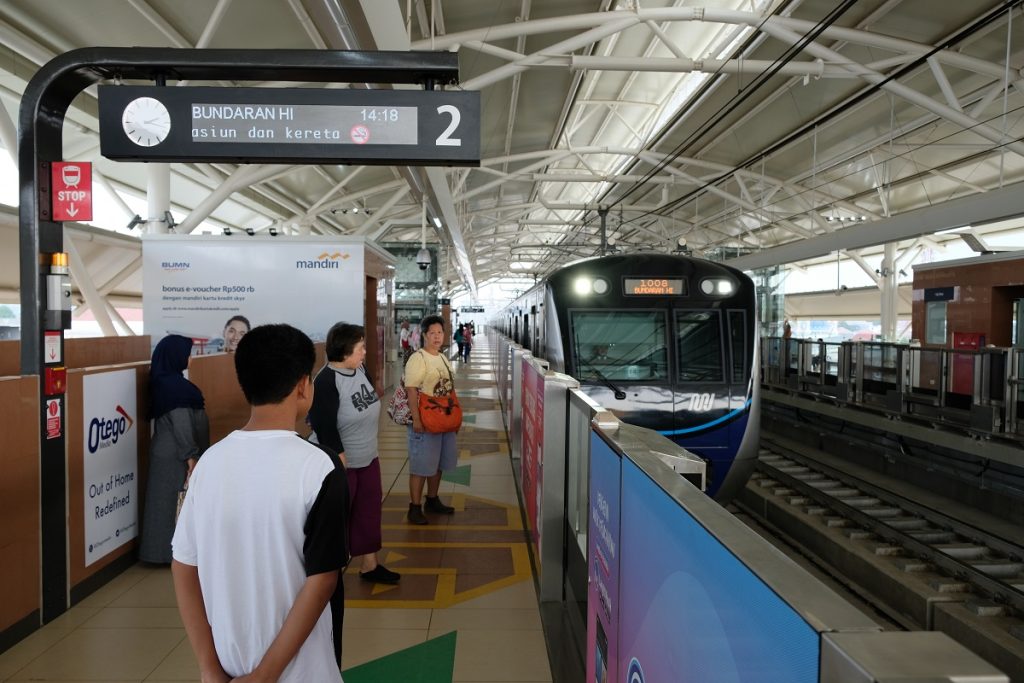First, let’s talk about the brand-new MRT (Mass Rapid Transport) line Jakarta badly needed to alleviate its traffic problem. In the first few weeks after its inauguration in March 2019, people lined up with their families to try a transport system Indonesians could previously only experience abroad. The track stretches for 20 kilometers from the city’s main roundabout in Central Jakarta’s CBD, underneath the main avenue that connects Central Jakarta’s and South Jakarta’s business districts, all the way to the southwestern edge of the city. Although the closest MRT station is only around 4 kilometers away from where I live (I moved from West Jakarta to South Jakarta in 2012 and have been living in this part of the Indonesian capital since then), I waited a few more months until the euphoria died down a little before trying the new MRT with James for the very first time.
Surprisingly, the stations were practically spotless and almost everyone seemed to obey the rules, like standing on one side of the escalator. As I stepped inside the Japanese-made train, I had to pinch myself for it was a dream come true to take an underground metro system right here in Jakarta. I used to think that having the MRT would simply help people commute faster between their homes and offices. However, at M Bloc Space I learned that the mass transport system can actually bring a lot more benefits to the city and its people.
Formerly a 1950s-era warehouse and housing complex for the employees of the state-owned banknote printing company, M Bloc Space was abandoned in 2005 when the company moved to a production facility in a small city outside Jakarta and relocated its employees. As the MRT project unfolded, the government saw the potential to revive this derelict property as it would then be located within walking distance from two MRT stations once they were completed. Eventually, this newly-renovated compound was opened in October 2019, less than a year after the MRT trains began plying their route.
Designed as a family-friendly creative hub, M Bloc Space provides Jakartans with an alternative to air-conditioned malls. The former terraced houses were transformed into restaurants serving an array of Indonesian and Western dishes, a shop filled with items from local independent brands, an Indonesian comic book store, a gelato café that serves unusual flavors (from speculaas – spiced biscuits the Dutch introduced to the Indonesians – to kale and red cabbage), another café specializing in jamu (Indonesian traditional herbal drinks), and a shop selling all manner of vintage items, among other things. What makes those shops even more exciting is the fact that some of them also act as discussion spaces, bringing experts, aficionados and the general public together in one place. Behind the row of former houses, the old warehouse has been turned into a money printing-themed restaurant that has kept its industrial ambiance, albeit softened by tropical plants, as well as a hall for both big-name and independent artists to perform.





Farther down the MRT line to the south are some areas I rarely went to in the past because of the distances I had to cover to reach them. One interesting locale is Cipete, a mixed residential area with houses, trendy cafés, some supposedly good restaurants, as well as the Lycée Français de Jakarta – the city’s French international school. Living in a city where less of 15% of its land is green space (far below the minimum 30% many urban planning experts recommend), I always appreciate a place that provides a little greenery, and I found L.O.F. Kitchen and Plants in Cipete to be one such venue. It started as a neighborhood store that sold plants and gardening tools. However, one day the owner decided to open a small restaurant as well, turning this place into a little lush oasis for friends to hang out together. After all, what’s not to love about having a big kimchi and cheese burger, served with gochujang mayo and fries, surrounded by all kinds of plants? Who wouldn’t enjoy this peaceful ambiance in a hectic city like Jakarta?
A little off the MRT line, but still easily accessible by TransJakarta buses is, in my opinion, one of the coolest places in South Jakarta, if not the entire city. Pasar Santa was built in 1971 as a modern two-story structure for a traditional market. Over time, its upper floor became largely deserted as most trade activities happened downstairs. However, in 2014 a group of young Jakartans saw its low rents as an opportunity, and soon enough they came in droves, setting up a new crop of small businesses on the previously quiet upper floor. Then came greed. Tempted by the sudden influx of money and visitors Pasar Santa was receiving, the market’s management company decided to raise the rent four to fivefold, subsequently resulting in the exodus of many tenants to other places with more reasonable rates.